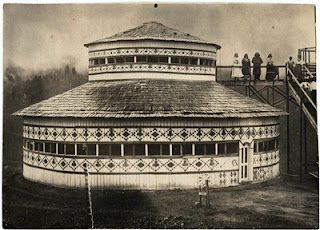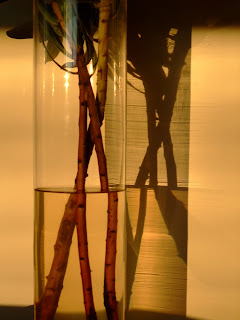
Monday, September 29, 2008
On the edge

Saturday, September 27, 2008
Rain ... Tears ...

From Rain of the Children, the round meeting house, Hiona, in the background ... built as part of the vision of the prophet Rua Kenana .. amidst the swirling mist of the Ureweras.

Hiona (Zion), c.1902
Thursday, September 25, 2008
MIA
"I don't believe in God, but I do miss him." Julian Barnes, Nothing to be Frightened of (2008).

Venice, The Lido, December 1992, J Bowring
"I feel that there is much to be said for the Celtic belief that the souls of those whom we have lost are held captive in some inferior being, in an animal, in a plant, in some inanimate object, and thus effectively lost to us until the day (which to many never comes) when we happen to pass by a tree or to obtain possession of the object which forms their prison. Then they start and tremble, they call us by our name, and as soon as we have recognised their voice the spell is broken. Delivered by us, they have overcome death and return to share our life."
Marcel Proust, The Remembrance of Things Past (1913)
"And these things that live,slipping away, understand that you praise them;transitory themselves, they trust us for rescue,us, the most transient of all. They wish us to transmute them in our invisible heart--oh, infinitely into us! Whoever we are."
Rainer Maria Rilke (C. F. MacIntyre, translation) "The Ninth Elegy" Duino Elegies (1911-1922)
"They are not outside us, nor even entirely within, but flow back and foth between us and the objects we have made, the landscape we have shaped and move in .
We have dreamed all these things in our deepest lives and they are ourselves. It is our self that we are making out there, and when the landscape is complete we shall have become the gods who are intended to fill it."
David Malouf, An Imaginary Life (1978)
Tuesday, September 23, 2008
Theatre of the Night Mind
Vague impressions.
Fragments, barely eidetic.
Figments, lingering, not narrative.
But such as had gathered over the day,
over the past months, years,
accumulating, accruing...
gathering interest ...
waiting for the Theatre of the Night Mind.
Sight becomes touch.
Sensual transgressions take place.
A synaesthetic exchange, this for that.
And all is elusive, liquid, fugitive.
Friday, September 19, 2008
The Mystery of the Visible II

Tuesday, September 16, 2008
Circling

Rene Magritte, Castle in the Pyrenees
Tuesday, September 9, 2008
Bells / Birds
Godwit Bells: Nga Kuaka Hokinga Mai
Mariners of deep space
deep space
deep
deep
space
feathered with hunger
you all
fall
fall
and fall
with grace
in your blasted flock that faster
and faster
fasted so long//traditional signs of
my NAC DC-3:ah
kuaka! kuaka! kuaka!
potent as Hotere brushing the air
painting the shore
with the landing of feathers
of hair
on blood. & for time
travellers space unravellers hero
Odysseans
they rang the bells
Cathedral bells bells of Old Babel
they rang for you
home! home! brave on the the
estuary shivering
all but
dead
but home.
Jeffrey Paparoa Holman
Monday, September 8, 2008
Seeing Things

Following along from the Blue Flower / Red Flower in the Little Blue Guide, and of the play of light, and of the blue tulip ... thoughts on optics and ambience are swirling about. Contemplating the intersection of phenomenology and metaphysics, and returning to the work of French landscape theorist, Bernard Lassus. An early experiment of delicious simplicity became known as Un Air Rose, of which, unfortunately no colour images appear to exist. Placing a slice of white paper within the red tulip, the colour appeared to bleed across onto the white, to escape its very thingness, its quiddity, and become metaphysically animated. (One could, of course, 'try this at home', and revel in the revelation of defamiliarised optical effects).
Which leads one to Goethe, writer of Werther, and sometime colour theorist. Resisting the objectivity of optics, Goethe developed a subjective theory on the phenomena of colour, one which seems to hold tight to the early sense of 'aesthetics' as being more than simple visuality, but, well, some-thing else. And his observations on the way that colour arises 'at the edges' echoes with Lassus's observation on the Tulip, of the suffusing of colour into that which surrounds the object. Somehow so very much more affective, than the physical theories of optics, and which inform the condensation of colour that is different to that 'observed', as in my current Polaroid experimentation, that there is a haunting of the ether, a spectre in the spectrum ...

Wednesday, September 3, 2008
The Mystery of the Visible

The mysteries of the world continue in their gorgeous beauty. Imagery condensing upon a surface, the dark magic of the camera obscura, the remarkable late flowerings of the cremated remains of the insane ... and, now, Polaroid photography. Walter Benjamin warned of the loss of aura in the age of mechanical reproduction, and the Polaroid photograph bypasses this. It is a true original, aura inheres in here, in the photographic surface. The image emerges from nothing, slowly forming upon the surface, first ghostly, then darkening. Bedazzling ...
"Things are never what they appear to be." Abelardo Morell

